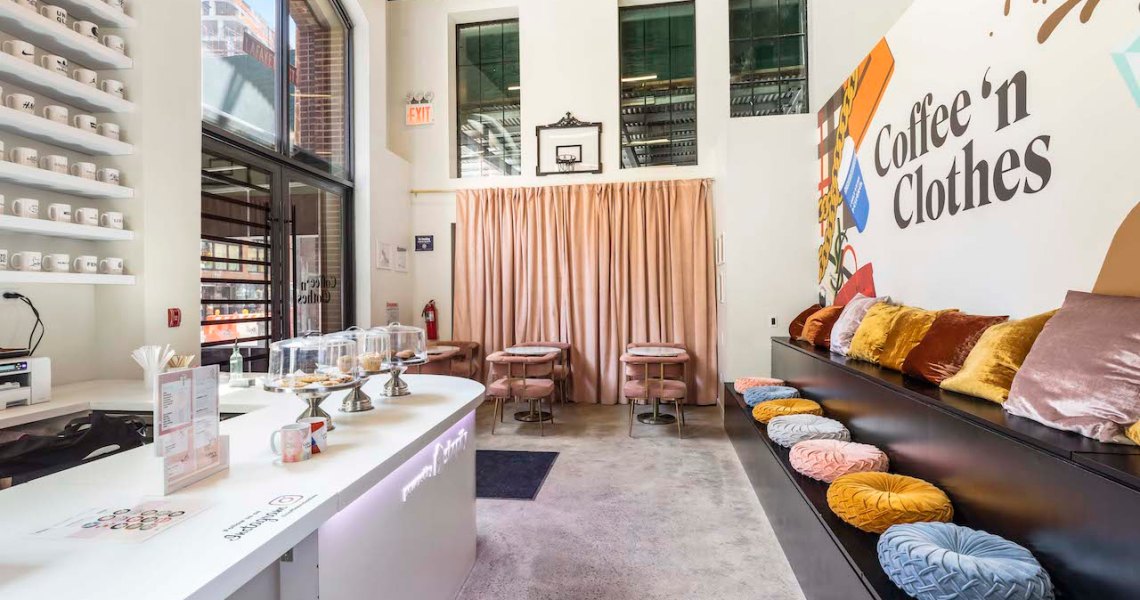Multi-brand retail platforms from Bulletin to Re:store are increasingly opening doors to assist direct-to-consumer brands’ transition into physical retail. Showfields is nearing its one-year mark, since opening in NYC in December 2018, and is finding success in its evolved department store model.
Late last month, the store shut down for four days. When it reopened, it had a completely revamped layout, complete with 80% new inventory and 11 new brands including wellness company Almēda Labs, premium CBD company Feals, handbag brand GiGi New York and Swedish sleepwear brand Dagsmejan.
While some brands have come and gone, others have stayed since the beginning. The latter includes vintage luxury resale company Treasures of NYC, vegan skin-care brand Nuria and electric toothbrush company Quip. Nuria, which itself launched only a few weeks before Showfields, owed the early traction the brand has seen to its Showfields partnership.
Nuria started with a booth inside of the multi-brand retail space. In late July, Nuria moved into House of Showfields, which is positioned as a 30-minute experience and features six brands, currently including smoothie company Kencko and smart sponge brand Skura. Positioned as retail theater, the experience is designed to get customers to touch, smell and even taste some of the brands using 14 hired actors to educate shoppers about the brands. The interactive element is something that is helping to set retail concept spaces like Showfields apart from traditional department stores, said Dave Mayer, senior partner in brand strategy at creative consultancy Lippincott.
“It’s a rethinking of the business model ,which is less about what amounts the brand is direct-selling through Showfields and more about how they are building an emotional experience with customers that is going to drive acquisition. It becomes more about marketing than sales,” said Mayer. “The question I have is whether Showfields can be commercially successful, because it requires a lot of real estate; its sales density is far lower to create these experiences than for a traditional store.”
For Nuria, the experience in House of Showfields focuses on its exfoliator. Every customer that comes through House of Showfields tests the product on their hands, allowing them to get a better sense of its feel and effectiveness.
“Unlike at Sephora, 100% of the people going to House of Showfields are actually trying the product — and as a result, many are buying it,” said Katie Hunt, Showfields chief revenue officer.
Ad position: web_incontent_pos1
Since moving to the more interactive experience within Showfields, Nuria’s sales almost instantly doubled, said Dawn Kidd, the brand’s chief marketing officer. Prices for a space in Showfields start at $6,000 a month, but scale up based on the location and the amount of square footage a brand has. Brands keep all profits from sales. A space in House of Showfields starts at $4,000 a month.
But with so many brands filling the four-story, 14,000-square-foot concept store, there’s no guarantee that customers who come into the store will engage with any one brand. Especially since every other brand in the space is doing all it can to gain eyeballs and win over customers.
“My concern [with multi-brand retail platforms] is the constraint on how many brands can really participate in a given store and a given time. Your space to really showcase your brand, to showcase your product is somewhat limited,” said Rob Haslehurst, managing director at management consulting firm L.E.K. Consulting. “These are not going to be massive revenue drivers for these brand.”
Showfields said that once House of Showfields opened in late July, brands that moved to the space from a booth saw, on average, four times as many sales than in weeks prior. The rest of the store (outside of House of Showfields) saw a 33% increase in traffic. Overall, since House of Showfields opened, the entire store has seen sales jump 50%.
Hunt said one of the biggest opportunities she sees for brands in partnering with Showfields (outside of the exposure, especially for newer DTC brands) is the data and information her team can provide. Inside the NYC space, Showfields has one sensor for every 90-square-feet of store space. Those sensors provide real-time data to each and every brand inside Showfields, using heat mapping, to show what products customers are touching, picking up and lingering in front of, for example.
Ad position: web_incontent_pos2
“One brand started out with 20 hero products in their space and, based on the data, we merchandised down to six products and watches sales go up 160% in a week,” Hunt said.




